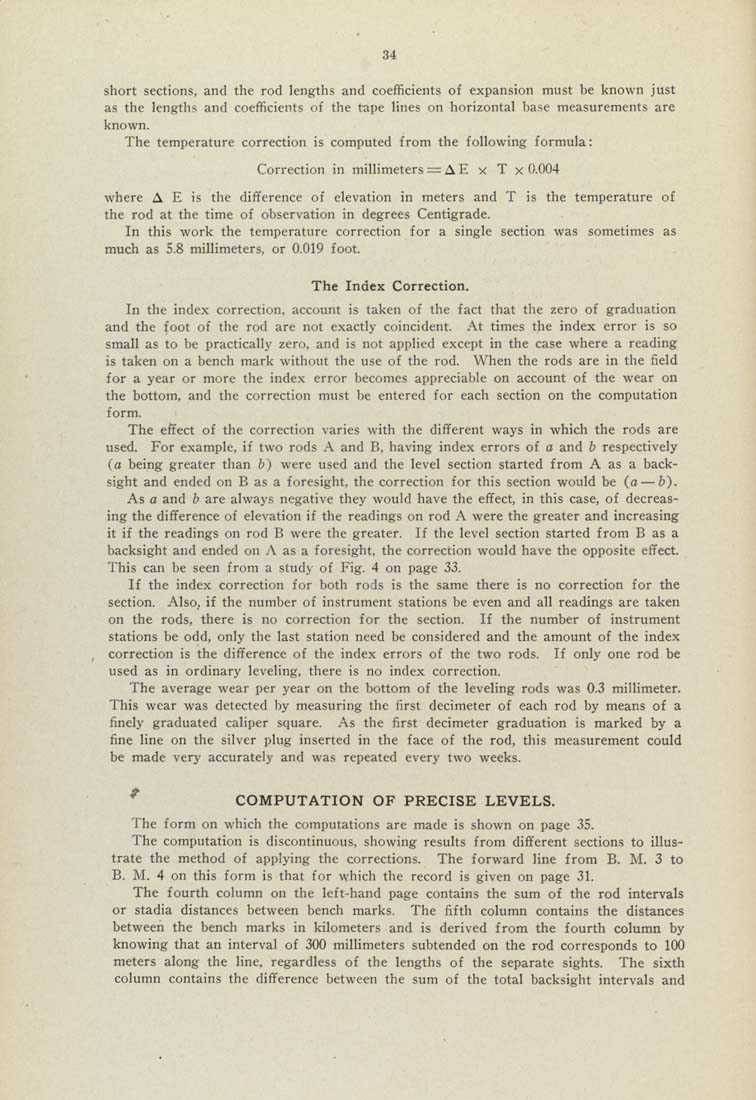34
short sections, and the rod lengths and coefficients of expansion must be know'n just
as the lengths and coefficients of the tape lines on horizontal base measurements are
known.
The temperature correction is computed from the following formula:
Correction in millimeters^^ A E x T x 0.004
where A E is the difference of elevation in meters and T is the temperature of
the rod at the time of observation in degrees Centigrade.
In this work the temperature correction for a single section was sometimes as
much as 5,8 millimeters, or 0,019 foot.
The Index Correction.
In the index correction, account is taken of the fact that the zero of graduation
and the foot of the rod are not exactly coincident. At times the index error is so
small as to be practically zero, and is not applied except in the case where a reading
is taken on a bench mark without the use of the rod. When the rods are in the field
for a year or more the index error becomes appreciable on account of the wear on
the bottom, and the correction must be entered for each section on the computation
form.
The effect of the correction varies with the different ways in which the rods are
used. For example, if two rods A and B, having index errors of a and b respectively
(a being greater than b) were used and the level section started from A as a back¬
sight and ended on B as a foresight, the correction for this section would be (a — b).
As a and b are always negative they would have the effect, in this case, of decreas¬
ing the difference of elevation if the readings on rod A were the greater and increasing
it if the readings on rod B were the greater. If the level section started from B as a
backsight and ended on A as a foresight, the correction would have the opposite effect.
This can be seen from a study of Fig. 4 on page 33.
If the index correction for both rods is the same there is no correction for the
section. Also, if the number of instrument stations be even and all readings are taken
on the rods, there is no correction for the section. If the number of instrument
stations be odd, only the last station need be considered and the amount of the index
correction is the difference of the index errors of the two rods. If only one rod be
used as in ordinary leveling, there is no index correction.
The average wear per year on the bottom of the leveling rods was 0,3 millimeter.
This wear was detected by measuring the first decimeter of each rod by means of a
finely graduated caliper square. As the first decimeter graduation is marked by a
fine line on the silver plug inserted in the face of the rod, this measurement could
be made very accurately and was repeated every two weeks.
^ COMPUTATION OF PRECISE LEVELS.
The form on which the computations are made is shown on page 35.
The computation is discontinuous, showing results from different sections to illus¬
trate the method of applying the corrections. The forward line from B, M, 3 to
B, M, 4 on this form is that for which the record is given on page 31.
The fourth column on the left-hand page contains the sum of the rod intervals
or stadia distances between bench marks. The fifth column contains the distances
between the bench marks in kilometers and is derived from the fourth column by
knowing that an interval of 300 millimeters subtended on the rod corresponds to 100
meters along the line, regardless of the lengths of the separate sights. The sixth
column contains the difference between the sum of the total backsight intervals and
|








